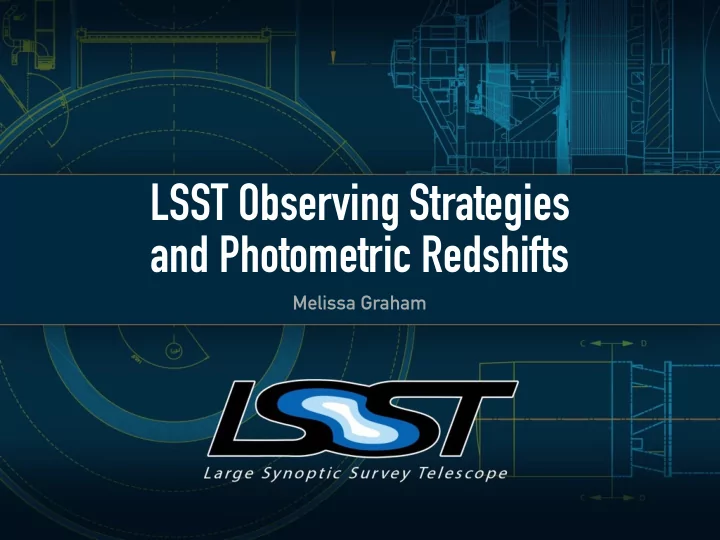

LSST Observing Strategies and Photometric Redshifts Melissa Graham
CMNN: Color-Matched Nearest-Neighbors Training Set: galaxies with “true” (spectroscopic) redshift galaxies for which z phot is estimated Test Set: Step 1 For every test set galaxy, calculate the Mahalanobis distance in color-space to every training set galaxy. How does it work? 𝑑 = color 𝜀𝑑 = error in color (Where color is the difference in brightness between adjacent filters: u-g, g-r, r-i, i-z, z-y.) Step 2 Apply a threshold on D M to identify the subset of training galaxies that are “well-matched” in color-space. Choose 1 color-matched training-set galaxy and use its “true” redshift as the photo-z for the test galaxy. Graham, Connolly, Ivezi ć , Schmidt et al. (2018) 2
CMNN: Color-Matched Nearest-Neighbors Training Set: galaxies with “true” (spectroscopic) redshift galaxies for which z phot is estimated Test Set: Simulated photometry scattered by predicted observational errors. Graham, Connolly, Ivezi ć , Schmidt et al. (2018) 3
CMNN: Color-Matched Nearest-Neighbors How will the photo- z improve as the LSST photometric uncertainties decrease over the 10 year survey? Arrows mark year when SRD values met. Graham, Connolly, Ivezi ć , Schmidt et al. (2018) 4
CMNN: Color-Matched Nearest-Neighbors Graham et al. 2018 also considers: — potential changes to the LSST observing strategy, such as the distribution of visits per filter —> e.g., less u - or y -band, gri only during year 1 — impact of general coefficients to, and systematic offsets, on the photometric errors — consequences of a mismatch in color or redshift distributions between test and training sets — whether a subtle change in effective filter transmission due to airmass can be used to refine photo- z estimates Graham, Connolly, Ivezi ć , Schmidt et al. (2018) 5
CMNN: Impacts of NIR/NUV Photometry Work In Progress Paper nearly ready showing simulations of LSST photo-z results when photometry from: - ESA Euclid (NIR) - NASA WFIRST (NIR) - CSA CASTOR (NUV) are included in the simulation. C osmological A dvanced S urvey T elescope for O ptical and UV R esearch Graham, Connolly, et al. (2018b, in prep.) 6
CMNN: Impacts of NIR/NUV Photometry Euclid: impact within the overlapping area (LSST + Euclid) The paper also evaluates: • results considering Euclid is 40% of the total WFD area • results in a shallow Northern LSST survey to extend Euclid overlap • results with a deeper training set built from overlapping DDF Graham, Connolly, et al. (2018b, in prep.)
CMNN: Impacts of NIR/NUV Photometry WFIRST: impact within the overlapping area (~2000 sq.deg.) The paper also evaluates: • results with only WFIRST YJHK • results for a deeper test set of i<26.8 mag Graham, Connolly, et al. (2018b, in prep.) 8
CMNN: Impacts of NIR/NUV Photometry CASTOR: impact within the overlapping area (~6000 sq.deg.) The paper also evaluates: • results with CASTOR + Euclid in the 6000 sq.deg • results with CASTOR + WFIRST in the southern 2000 sq.deg. Graham, Connolly, et al. (2018b, in prep.) 9
CMNN: Results from OpSim Runs Photometric Depth Evolution of OpSim Runs Divide the OpSim runs into three categories: (1) enlarge the total survey area , (2) change the survey’s visits, and (3) do a rolling cadence. Plot median depth of extragalactic WFD fields with >3 filters vs. year. 10
CMNN: Results from OpSim Runs Photometric Depth Evolution of OpSim Runs Divide the OpSim runs into three categories: (1) enlarge the total survey area, (2) change the survey’s visits , and (3) do a rolling cadence. Plot median depth of extragalactic WFD fields with >3 filters vs. year. 11
CMNN: Results from OpSim Runs Photometric Depth Evolution of OpSim Runs Divide the OpSim runs into three categories: (1) enlarge the total survey area, (2) change the survey’s visits, and (3) do a rolling cadence . Plot median depth of extragalactic WFD fields with >3 filters vs. year. 12
CMNN: Results from OpSim Runs Photo-z Quality Evolution for 3 OpSim Runs (1 per Category) Compare the statistical quality of photo-z in extragalactic WFD fields to the baseline, as a function of z phot , for each year. PanSTARRS-like area; 40/20s u/grizy visits; two 𝜀 -band roll 13
CMNN: Results from OpSim Runs Photo-z Quality Evolution for 3 OpSim Runs (1 per Category) Compare the statistical quality of photo-z in extragalactic WFD fields to the baseline, as a function of z phot , for each year. PanSTARRS-like area; 40/20s u/grizy visits; two 𝜀 -band roll 14
CMNN: Summary The CMNN code is for evaluating the relative photo-z quality between observing strategies that change the photometry. Photo-z results can be point estimates, full posteriors, or bulk statistical measures (standard deviation, bias, fraction of outliers). Documents exist that quantify the effects on photo-z from changes to the observing strategy, and overlap with NIR/NUV surveys. I’m happy to take requests for photo-z quality simulations that would help evaluate proposed cadences for white papers. Melissa Graham, mlg3k@uw.edu 15
Recommend
More recommend